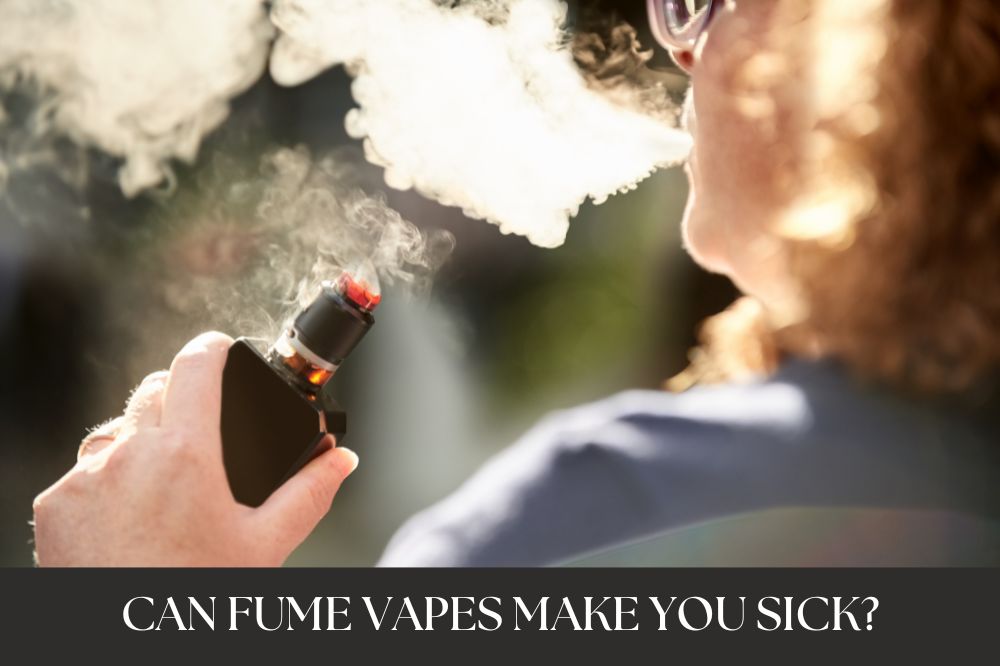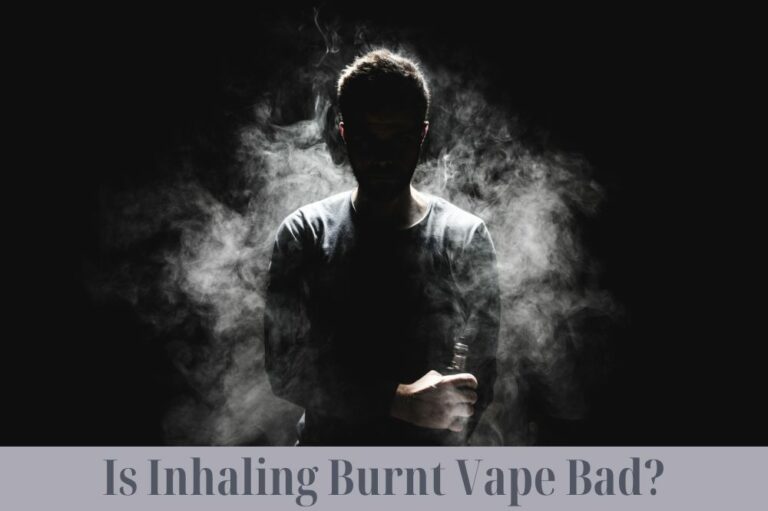
If you’re a vaper, you may be wondering if fume vapes can make you sick. The short answer is yes, they can. Fume vapes, also known as vape pens or e-cigarettes, are a popular alternative to traditional cigarettes. They work by heating up a liquid that contains nicotine, flavorings, and other chemicals, turning it into a vapor that you inhale.
While fume vapes are often marketed as a safer alternative to smoking, there are still health risks associated with using them. Some of the chemicals found in e-cigarette vapor have been linked to lung damage, respiratory problems, and other health issues. In addition, the nicotine in fume vapes can be addictive and may cause side effects like headaches, nausea, and dizziness. If you’re concerned about the potential health risks of fume vapes, it’s important to do your research and talk to your doctor.
Understanding Vapes and Fumes
If you’re wondering whether fume vapes can make you sick, it’s important to first understand what they are. Fume vapes, also known as e-cigarettes or electronic cigarettes, are devices that heat up a liquid (sometimes called e-juice or vape juice) to create an aerosol, which is then inhaled. This aerosol is often flavored and may contain nicotine or other chemicals.
While e-cigarettes have been marketed as a safer alternative to traditional cigarettes, there is still much that is unknown about their long-term health effects. While some studies have suggested that e-cigarettes may be less harmful than traditional cigarettes, others have raised concerns about the potential risks of using these devices.
One of the main concerns with e-cigarettes is the chemicals that are released when the liquid is heated and turned into an aerosol. While some of these chemicals are harmless, others may be toxic or carcinogenic. For example, a study by the FDA found that some e-cigarette liquids contained diacetyl, a chemical that has been linked to a serious lung disease known as popcorn lung.
In addition to the potential risks associated with the chemicals in e-cigarette liquids, there are also concerns about the effects of inhaling the aerosol itself. While the aerosol is often referred to as “vapor,” it is not actually water vapor and may contain particles that can be harmful to your health. These particles can include heavy metals, volatile organic compounds (VOCs), and ultrafine particles that can be inhaled deep into the lungs.
Overall, while e-cigarettes may be less harmful than traditional cigarettes, they are not without risks. If you’re considering using e-cigarettes, it’s important to do your research and understand the potential risks involved.
SPIRITBAR Katana BP10000
- Slender, leather-textured body reminiscent of a katana handle for an authentic samurai feel
- Unique samurai-inspired e-liquid flavor - fruity yet not too sweet, with a luxurious, elegant aroma
- Powerful 650mAh rechargeable battery for extended vaping time
- Large 18ml e-liquid capacity and 10,000 puff capacity
- Advanced mesh coil and e-liquid & power display screens for optimal vaping experience
The special juice captures the essence of the samurai spirit with its rich, smoothly pulsating flavor that brings new satisfaction with every puff. The device's slender, leather-textured design evokes the grip of a samurai's katana, making this product a perfect choice for beginner vapors.
Health Risks of Vaping
Vaping has become increasingly popular in recent years as an alternative to smoking. However, there are still many unknowns about the long-term health effects of vaping. Here are some potential health risks associated with vaping:
1. Respiratory Issues
Vaping can cause irritation and inflammation in the lungs, leading to coughing, wheezing, and shortness of breath. In some cases, it can even lead to more serious conditions like bronchitis and pneumonia. The particles in the vapor can also cause damage to the lung tissue, increasing the risk of respiratory infections.
2. Nicotine Addiction
Most e-cigarettes contain nicotine, which is highly addictive. Nicotine can increase blood pressure, heart rate, and the risk of heart attack. It can also have negative effects on brain development in young people.
SPIRITBAR Jack’s Flask 9000 Puffs
- Stylish pirate flask-shaped body providing an exciting vaping experience
- Delivering up to 9000 puffs per device
- 20ml e-liquid capacity with 50mg nicotine strength for satisfying throat hit
- Specialized pirate-themed e-juice flavors for rich, swirling taste
- Premium mesh coil optimizes flavor profile for maximum vaping enjoyment
This disposable vape captures the daring spirit of the high seas with its flask styling and signature pirate e-juice flavors. The extraordinary battery life provides 9000 indulgent puffs for extended vaping pleasure. Live boldly and freely with the Jack's Flask - a legendary vaping experience fit for a pirate's adventures.
3. Chemical Exposure
The liquid used in e-cigarettes contains a variety of chemicals, including propylene glycol, glycerin, and flavorings. When heated, these chemicals can produce harmful byproducts like formaldehyde and acetaldehyde. Some of these chemicals have been linked to cancer and other health problems.
4. Vaping-Related Illnesses
In recent years, there have been reports of a vaping-related illness known as EVALI (e-cigarette or vaping product use-associated lung injury). Symptoms include cough, chest pain, shortness of breath, fever, and fatigue. In severe cases, it can lead to hospitalization and even death.
Overall, while vaping may be a less harmful alternative to smoking, it is not without its risks. If you do choose to vape, it is important to be aware of the potential health effects and take steps to minimize your risk.
Immediate Effects of Vape Fumes
If you are a vaper, you may have experienced some immediate effects of vape fumes. Vape fumes are produced when e-liquids are heated by the device and inhaled into your lungs. Here are some of the immediate effects of vape fumes:
- Dry Mouth: Vaping can cause dry mouth, also known as xerostomia. This occurs because the e-liquids used in vaping can reduce saliva production in your mouth. This can lead to bad breath, tooth decay, and gum disease.
- Dizziness: Vaping can cause dizziness, especially if you are new to vaping or if you are using a high-nicotine e-liquid. Nicotine is a stimulant that can cause lightheadedness, dizziness, and even nausea.
- Headache: Vaping can cause headaches, especially if you are using a high-nicotine e-liquid or if you are vaping for an extended period. Nicotine is a vasoconstrictor, which means it can reduce blood flow to the brain and cause headaches.
- Coughing: Vaping can cause coughing, especially if you are using a high-nicotine e-liquid or if you are vaping for an extended period. Coughing is your body’s way of trying to clear your airways of irritants.
- Throat Irritation: Vaping can cause throat irritation, especially if you are using a high-nicotine e-liquid or if you are vaping for an extended period. The heat and chemicals in the e-liquid can irritate your throat and cause soreness.
- Nosebleeds: Vaping can cause nosebleeds, especially if you are using a high-nicotine e-liquid or if you are vaping for an extended period. Nicotine can cause blood vessels in your nose to constrict, leading to nosebleeds.
It is important to note that these immediate effects are usually mild and temporary. However, if you experience any severe or persistent symptoms, you should seek medical attention.
Long-Term Effects of Vape Fumes
If you’re wondering whether fume vapes can make you sick, the answer is yes. While the short-term effects of vaping may not be as severe as those of smoking cigarettes, the long-term effects can be just as damaging. Here are some of the potential long-term effects of inhaling vape fumes:
Lung Damage
Vaping can cause significant damage to your lungs over time. The chemicals and particles in vape fumes can irritate and inflame the delicate tissues of your lungs, leading to chronic bronchitis, emphysema, and other respiratory conditions. In some cases, vaping can even cause lung cancer.
Cardiovascular Disease
Vaping can also increase your risk of developing cardiovascular disease. The nicotine in vape juice can cause your blood vessels to constrict, which can increase your blood pressure and put a strain on your heart. Over time, this can lead to heart disease, heart attack, and stroke.
Immune System Suppression
Vaping can also suppress your immune system, making you more susceptible to infections and illnesses. The chemicals in vape fumes can damage the cells in your lungs and weaken your body’s ability to fight off infections.
Other Health Risks
In addition to these long-term effects, vaping can also increase your risk of other health problems, such as:
SPIRITBAR Katana BP10000
- Slender, leather-textured body reminiscent of a katana handle for an authentic samurai feel
- Unique samurai-inspired e-liquid flavor - fruity yet not too sweet, with a luxurious, elegant aroma
- Powerful 650mAh rechargeable battery for extended vaping time
- Large 18ml e-liquid capacity and 10,000 puff capacity
- Advanced mesh coil and e-liquid & power display screens for optimal vaping experience
The special juice captures the essence of the samurai spirit with its rich, smoothly pulsating flavor that brings new satisfaction with every puff. The device's slender, leather-textured design evokes the grip of a samurai's katana, making this product a perfect choice for beginner vapors.
- Mouth and throat irritation
- Headaches
- Nausea and vomiting
- Dizziness
- Seizures
Overall, the long-term effects of vaping are still being studied, but the evidence suggests that vaping can be just as harmful as smoking cigarettes. If you’re concerned about the potential health risks of vaping, it’s important to talk to your doctor and consider quitting.
Can Vape Fumes Make You Sick?
If you’re a vaper, you may have wondered whether the fumes from your vape can make you sick. While vaping is generally considered less harmful than smoking cigarettes, there is still some concern about the potential health effects of inhaling vape fumes.
One of the main concerns is the potential for secondhand vape exposure. Just like with cigarette smoke, there is a risk of inhaling secondhand vape fumes if you’re around someone who is vaping. According to Healthline, inhaling secondhand vape fumes can cause irritation of the eyes, nose, and throat, as well as headaches and nausea.
Another concern is the potential for chemicals in vape fumes to be harmful to your health. While e-cigarettes do not contain tobacco, they do contain a variety of chemicals, including nicotine, flavorings, and other additives. According to WebMD, inhaling these chemicals can cause a range of symptoms, including coughing, shortness of breath, chest pain, and nausea.
It’s important to note that the long-term health effects of vaping are still not well understood. While some studies have suggested that vaping may be less harmful than smoking cigarettes, others have raised concerns about the potential health risks. If you’re a vaper, it’s important to be aware of the potential risks and to take steps to minimize your exposure to vape fumes. This may include avoiding secondhand vape exposure and using e-cigarettes with caution.
Symptoms of Sickness from Vape Fumes
If you have been exposed to vape fumes, you may experience various symptoms. Here are some of the most common ones:
Respiratory Symptoms
Vape fumes can irritate your respiratory system, causing coughing, wheezing, and shortness of breath. If you already have asthma or other respiratory conditions, exposure to vape fumes can exacerbate your symptoms.
Gastrointestinal Symptoms
Inhaling vape fumes can also cause gastrointestinal symptoms such as nausea, vomiting, and diarrhea. These symptoms can be especially severe if you accidentally swallow some of the vape liquid.
Skin and Eye Irritation
Exposure to vape fumes can cause skin and eye irritation, especially if you come into direct contact with the liquid. If you get vape liquid on your skin or in your eyes, rinse it off immediately with plenty of water.
Headaches and Dizziness
Vape fumes can also cause headaches and dizziness, especially if you are exposed to them for an extended period of time. If you experience these symptoms, move to a well-ventilated area and get some fresh air.
Other Symptoms
Some people may experience other symptoms after exposure to vape fumes, such as fatigue, fever, or muscle pain. If you experience any of these symptoms, seek medical attention immediately.
In summary, exposure to vape fumes can cause a range of symptoms, including respiratory symptoms, gastrointestinal symptoms, skin and eye irritation, headaches and dizziness, and other symptoms. If you experience any of these symptoms after exposure to vape fumes, seek medical attention immediately.
Preventing Sickness from Vape Fumes
To prevent sickness from vape fumes, there are several things you can do. Here are some tips to help you stay healthy while vaping:
1. Choose High-Quality Vape Juice
One of the most important things you can do to prevent sickness from vape fumes is to choose high-quality vape juice. Look for vape juice that is made from high-quality ingredients and is free from harmful chemicals. Check the label to make sure it is made in a reputable facility and has been tested for safety.
2. Avoid Overheating Your Vape Device
Overheating your vape device can cause the e-liquid to break down and release harmful chemicals into the air. To avoid this, make sure you are using your device correctly and not overheating it. Follow the manufacturer’s instructions and avoid using your device for extended periods of time.
3. Keep Your Vape Device Clean
Keeping your vape device clean is essential for preventing sickness from vape fumes. Regularly clean your device, including the tank, coil, and mouthpiece. This will prevent the buildup of harmful chemicals and bacteria.
4. Use Proper Ventilation
Using proper ventilation is important when vaping. If you are vaping indoors, make sure you have proper ventilation to prevent the buildup of harmful chemicals in the air. Open a window or use a fan to circulate the air.
5. Take Breaks
Taking breaks from vaping can also help prevent sickness from vape fumes. If you are vaping for an extended period of time, take breaks every 15-20 minutes to allow your body to recover.
By following these tips, you can help prevent sickness from vape fumes and stay healthy while vaping. Remember to always choose high-quality vape juice, avoid overheating your device, keep your device clean, use proper ventilation, and take breaks when needed.
Alternatives to Vaping
If you’re thinking about quitting vaping, there are several alternatives you can try. Here are some options:
- Nicotine Replacement Therapy (NRT): NRT products deliver nicotine to the body in a controlled way. This consistent dose can help ease nicotine withdrawal symptoms associated with quitting smoking or vaping. The five common NRT products include:
- Nicotine patch
- Nicotine gum
- Nicotine lozenge
- Nicotine spray
- Nicotine inhaler
These products are available over-the-counter and by prescription. Talk to your doctor to determine which NRT product is right for you.
- Medications: There are prescription medications that can help you quit vaping. These include bupropion and varenicline. Talk to your doctor about whether these medications are right for you.
- Behavioral therapy: Behavioral therapy can help you identify and change the behaviors that lead to vaping. This type of therapy can be done one-on-one with a therapist, or in a group setting.
- Cold turkey: Some people choose to quit vaping “cold turkey,” or without any assistance. This can be difficult, but it’s possible. If you choose this option, be prepared for withdrawal symptoms such as irritability, anxiety, and difficulty sleeping.
Remember, quitting vaping is a process. It may take several attempts before you’re successful. Don’t be discouraged if you slip up – just keep trying.








